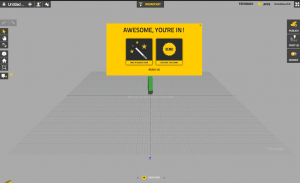Recently in the news there have been a number of mentions for a product called “Sunglass.io”. At the core it is a 3D viewer that runs on a browser. Although there is some good functionality to Sunglass as a viewer the founders and PR people are going crazy with hyperbole, referencing it as “Google Docs for 3D objects”. Docs offer a way to add, create, and fully edit documents as well as serving as a storage location for non-native file types. Sunglass can read and render a massive variety of CAD file types, a truly useful task, but it lacks the ability to edit or create models from scratch. It is NOT a modeling software which many publications either have overlooked or just misquoted in coverage, but that does not make it a functionless piece of software.
A quick run through of the Sunglass.io site had me very excited. For a CAD project the graphical interface (shown above) could be flashier, but it is running on a browser so speed and functionality should come first. Buttons are laid out nicely and everything is easy to understand. The ease with which a file can be added is amazing (the trusty drag and drop) but the manipulation of files is limited to scaling and reorienting it to create a scene. The notation abilities, speed of feedback and variety of file types it can handle honestly had me excited. With that level of communication available it is not always necessary to allow the ability for editing in a browser. Getting feedback from remotely located vendors and colleagues without having to transfer files types and use FTP would make life a lot easier during the design iteration process. To see if this was something to start using on a larger scale I dug into the terms of service, since the recent rumblings on CAD in the cloud have tuned my senses to these sorts of things.
The TOS has at least one portion that is concerning. Where I see some issue is of course the tricky business of ownership of the items that are created or uploaded to the Sunglass platform (emphasis mine).
You may not state or imply that your User Content is in any way provided, sponsored or endorsed by Company. Because you alone are responsible for your User Content (and not Company), you may expose yourself to liability if, for example, your User Content violates the Acceptable Use Policy. Company is not obligated to backup any User Content and User Content may be deleted at anytime. You are solely responsible for creating backup copies of your User Content if you desire. License. You hereby grant, and you represent and warrant that you have the right to grant, to Company an irrevocable, nonexclusive, royalty-free and fully paid, worldwide license to reproduce, distribute, publicly display and perform, prepare derivative works of, incorporate into other works, and otherwise use your User Content, and to grant sublicenses of the foregoing, solely for the purposes of including your User Content in the Site and Services. You agree to irrevocably waive (and cause to be waived) any claims and assertions of moral rights or attribution with respect to your User Content.
So in theory Sunglass can do what they like with the content. Some of this language is needed so that they can reproduce and run things on different servers etc. This makes perfect sense, but for a designer or engineer at a company you need to be certain Sunglass is cleared by your organization. (ie you have the right to grant a license). Stories abound of people not being able to use services like DropBox, because IT has somehow deemed them to be insecure.
My own understanding of the law is limited, and at some point I’ll discuss this with a lawyer, but on many sites where I do not understand the scope of the TOS is on the license you grant to the cloud company. From time to time it is important that they be able to use real users data in marketing materials etc. but should it not be standard to check with the user first? Rather than blanket getting agreement on all users content it seems the more reasonable approach would be to do this on a case by case basis. Google Docs TOS are much the same, but make the point of stating that you own your content, prior to the verbiage on granting licenses. That likely changes nothing but the psyche of someone reading the document, but that can be worth a lot. There are certainly many more questions that can be asked regarding ownership of content in the cloud and I plan to start digging for more. If you have any thoughts on the topic feel free to leave a comment.


